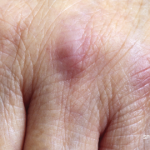“But we have hope,” we said, “and several treatment options, once we’ve confirmed what you have. We’re hopeful that we can halt the disease process and get you a degree of function back, but we do need some time and more tests.”
More tests. I hated saying that. It’s perhaps the truest statement we have, but who hasn’t hated the truth at least once?
She brushed a strand away from an irregularly receded hairline. “Will I be able to walk again?”
“I don’t know,” I said. “I hope you might be able to with treatment and significant rehab, but you have significant joint damage from calcium deposits and severe inflammation in your joints. It will be a long road.”
She knew that. She wasn’t stupid. She was a straight A student in high school. She tried to smile at us. “I can do the rehab.”
We discussed treatment options and, bloodwork pending, settled on a tentative one: continuation of low-dose steroids and addition of intravenous immunoglobulins while we sent safety labs for potential use of cyclophosphamide infusions. I signed orders, scheduled a return appointment and escorted her out. I watched her get wheeled away, while she was sitting up as straight as she could muster.
‘Judging by your history & exam, … the rash around your eyes, posterior neck, left arm, the back of your hands & feet; the way your muscles have weakened & wasted so quickly; & these hard lesions,’ I pointed at the ridges of calcinosis around her joints, on her jaw, arms & pressure points, ‘I think you have a form of dermatomyositis.’
Follow-through
As a hospitalist, I disliked not being able to see my patients all the way through treatment and outcome. Even when I made a useful diagnosis, I couldn’t follow my patients past the hospital doors. They went on to their primary care providers, cardiologists, pulmonologists, rheumatologists. Hospital medicine is essential to modern healthcare. It is also quintessentially halfway medicine, incomplete for many of its practitioners. Go to any community (or academic) hospital, and you’ll see how quickly it can become algorithmic. Requesting a consult can become a reflex. Order sets (standardized admission orders) become the quick template you use more and more to make it home for dinner. The excitement of learning and discovering fizzles out, leaving you an empty husk of who you once thought you wanted to be. Sometimes, I suspect the subsequent anhedonia, more than job stress, is the reason so many hospitalists can burn out. I know I did.



